DÉTAILS DE L'IMAGE

Galerie Kevorkian
'Buff ware bowl' with seated figure, animals and inscriptions
Persian art, Samanid dynasty
Earthenware pottery, painted in black, yellow and green under a transparent glaze
Eastern Iran (Khurasan), Nishapur, 10th century
H 6.2 cm; Ø 18.2 cm
Provenance: former collection P.M., Paris; Hôtel Drouot, 10 July 1980, lot 9
This bowl belongs to a particularly original production of medieval Iranian ceramics from the period of the Samanid dynasty (874-1005), almost exclusively attributable to the town of Nichapour in Khorassan (eastern Iran). This body of work, described as "buffware" by the Anglo-Saxons in reference to the colour of the earth, is distinguished by its polychromy, with the palette dominated by bright yellow, by the highly figurative tendency of its decorations and by an almost cubist treatment of the figures (notably combining frontal and profile views) and the "kaleidoscopic" arrangement of space. The pieces depicting figures are the rarest in this group, and the attitude of the figure (seated on, or more precisely above, what is probably a throne, holding a branch in one hand and the other with the index finger pointing towards his waist) is even more original. This rarity is matched by the great care and precision given to all the details of the decoration and the particularly elaborate costume, making the decoration of our bowl one of the most refined in this corpus. It combines on a single piece all the motifs that make up the decorative repertoire of this group: human, animal, plant and calligraphic representations. Another remarkable feature is its excellent state of preservation, with the glaze largely intact. This piece, acquired in 1980 at Hôtel Drouot, has since belonged to an important collector.



 TÉLÉCHARGER L'IMAGE
TÉLÉCHARGER L'IMAGE